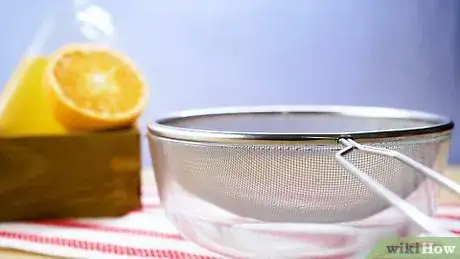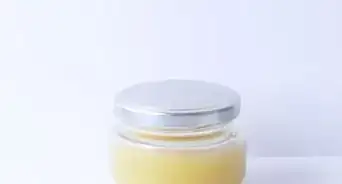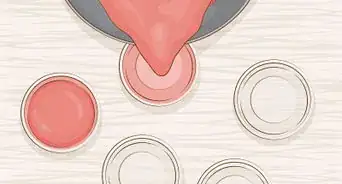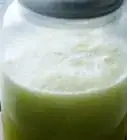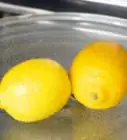This article was co-authored by wikiHow staff writer, Hunter Rising. Hunter Rising is a wikiHow Staff Writer based in Los Angeles. He has more than three years of experience writing for and working with wikiHow. Hunter holds a BFA in Entertainment Design from the University of Wisconsin - Stout and a Minor in English Writing.
There are 7 references cited in this article, which can be found at the bottom of the page.
The wikiHow Video Team also followed the article's instructions and verified that they work.
This article has been viewed 45,113 times.
Learn more...
Juicers typically remove pulp and plant fibers automatically, but blenders or juice presses will not. While it’s not required for you to strain your juice, there are a few easy ways you can try to get rid of the pulp. Most times, you can pour the juice through a mesh strainer to get rid of a majority of the pulp. If there are still fruit or vegetable fibers in your juice, try pouring it through a cheesecloth to get rid of the smaller pieces. When you’re finished, refrigerate or enjoy your juice!
Steps
Pouring Juice through a Strainer
-
1Set a fine-mesh strainer on top of a pitcher or bowl. Avoid using colanders or strainers that have large gaps since they will let more pulp or fibers through them. Set a large mixing bowl or pitcher on a sturdy work surface. Take the strainer and put it on top of a bowl or pitcher with tall sides so your juice doesn’t drip over the sides.[1]
- You can buy fine-mesh strainers from kitchen or restaurant supply stores.
- If the strainer doesn’t fit over the pitcher without hanging over the sides, set a funnel on top of the pitcher first before putting the bowl on it.
-
2Pour the juice through the strainer. Keep the juice you want to strain in a pitcher or a glass so it’s easier to pour. Slowly transfer the juice into the strainer, being careful so it doesn’t flow over the sides. Let the liquid completely drain through the strainer before pouring more through the strainer. Continue adding juice until the container is empty.[2]
- Strainers also work great if you want to remove the pulp from store-bought juices.
Advertisement -
3Push the pulp down with a rubber spatula to squeeze out the juice. Hold the strainer sturdy with your nondominant hand so it doesn’t fall out. Press down on any pulp or fibers leftover inside the strainer with the back of a rubber spatula, and let the juice drain into the bowl or pitcher. Apply firm pressure to the pulp to drain out as much juice as you’re able to before throwing the pulp away.[3]
- Be careful not to apply too much pressure, or you could break through the strainer.
Tip: Stir the leftover pulp every 1–2 minutes to ensure that you press out as much liquid as possible.
-
4Run the juice through the strainer again to remove additional fibers. It’s possible that some of the fruit or vegetable fibers got through the strainer and are still in the juice. Pour the juice into a clean container and rinse out the bowl or pitcher you used. Run the juice through the strainer once more to get rid of the excess pulp.[4]
- You may not need to run the juice through the strainer a second time.
Using a Cheesecloth
-
1Secure cheesecloth around the inside of a pitcher with a rubber band. Cheesecloth has tightly-woven fibers and works well for straining solid material from liquids. Stretch the cheesecloth over the top of a tall pitcher so it hangs down about 1–2 inches (2.5–5.1 cm) inside. Wrap a rubber band around the rim of the pitcher so it stays in place.[5]
- You can buy cheesecloth from kitchen or restaurant supply stores.
- You can also use coffee filters or milk bags, which are used to strain nut and soy milk, if you don’t have any cheesecloth.
-
2Pour the juice slowly into the cheesecloth. Keep the juice you want to strain in a pitcher or glass so it’s easier to transfer. Start pouring the juice through the cheesecloth at a steady pace so the pulp catches in the fibers. Allow the liquid to completely drain out from the cheesecloth before adding more of the juice.[6]
- Pour the juice around the sides of the cheesecloth since pulp will gather in the middle and make it drain slower.
-
3Squeeze the cheesecloth to remove excess juice from the fibers. Carefully pull off the rubber band and hold onto the corners of the cheesecloth. Gather the corners in the middle and twist the cheesecloth to wring out any of the juice stuck in the pulp. Squeeze the middle section of the cheesecloth tightly so the liquid drains out.[7]
- You can also press down on the pulp with a spoon or rubber spatula to press the liquid out.
Variation: You may also set the cheesecloth inside of a strainer and put a 5–10 lb (2.3–4.5 kg) weight wrapped in plastic wrap on top of it. Leave it in your fridge for 2–3 hours to press out any leftover juice.[8]
-
4Rinse out and wash the cheesecloth to clean out the pulp. Dump the excess pulp in a garbage can and run the cheesecloth under warm water. Rub off any pulp that’s still stuck in the cloth until there aren’t any solid pieces on it. Run the cheesecloth through your washing machine with your regular laundry load so you can use it again.[9]
- You can also throw away the cheesecloth when you’re finished.
Things You’ll Need
Pouring Juice through a Strainer
- Fine-mesh strainer
- Pitcher or bowl
- Rubber spatula
Using a Cheesecloth
- Cheesecloth
- Pitcher or bowl
- Rubber band
- Sink
References
- ↑ https://www.kitchensanity.com/juicing/how-to-juice-without-a-juicer/
- ↑ https://wishesndishes.com/green-juice-in-a-blender-no-juicer-required/
- ↑ https://wishesndishes.com/green-juice-in-a-blender-no-juicer-required/
- ↑ https://www.kitchensanity.com/juicing/how-to-juice-without-a-juicer/
- ↑ https://youtu.be/kSfOFxL8P0A?t=436
- ↑ https://youtu.be/Ev_GcTUZpfY?t=184
- ↑ https://youtu.be/kSfOFxL8P0A?t=454
- ↑ https://youtu.be/Ev_GcTUZpfY?t=226
- ↑ https://www.kitchensanity.com/juicing/how-to-juice-without-a-juicer/
About This Article
If you love fresh juice but aren’t crazy about the pulp, you can easily get rid of all those solids with a fine mesh strainer. Simply set the strainer in a large bowl or pitcher, then pour the juice in. Push the pulp or fibers against the mesh with a spoon or spatula to squeeze out any remaining juice. If you want to filter out any additional solids, pour the juice through the strainer a second time. To learn how to refine your juice even more by straining it through cheesecloth, read on!
